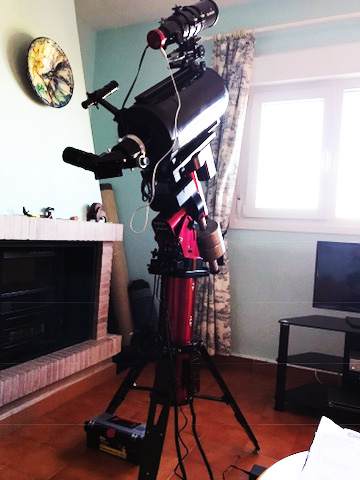Bright Potential Supernova in Tucana - Day 2.
 Thursday, October 30, 2014 at 7:23AM
Thursday, October 30, 2014 at 7:23AM Yesterday's discovery from the ASASSN team and subsequently imaged by me remotely in the afternoon is shown here in VPhot at the AAVSO. As I had used the iTelescope.com instrument T31 in Australia and had set up the link to the US based AAVSO it automatically transferred the image into the VPhot photometry software as soon as it completed the imaging run.
I set the PSN as a target and searched for comparison stars. There were none readily available as there would be for well known variable stars so I used the SkyX to find stars that were part of the Tycho catalogue. I know that this catalogue contains V and B data for each star so as I took a V image I used a star close to the target as a comparison. Strictly speaking I should have taken a B image as well and used both V and B magnitudes to generate transormation coefficients to apply to the magnitude measurement.
This shows the PSN and comparison star in VPhot
Here is a closer view
The result is here
I realise that the result of around 13.6 may not be very accurate as follows.
The exposure is too long (600s) giving a near saturated comparison star - I could not find a dimmer comparison star. As you can see from the images above there is too much difference in brightness between the target and comparison star. This may just be a case of me needing to try harder to find a suitable V value comparison.
Here is the target showing the aperture - the inner measurement circle , the gap and the outer "sky" background annulus. As you can see the situation is complicated because behind the target is the light from the sky background AND the light from the galaxy itself. The outer annulus by necessity cuts through a region of just sky and a region of sky plus galaxy. The magnitude calculation determines the average background value per pixel within this annulus - multiplies it by the number of pixels within the aperture and subtracts the result from the measured total count within the aperture. (Total count is obtained by adding all the individual counts within the aperture. ) So - is that good enough - I need to find more information from the experts on that.
I chose the aperture and annulus sizes so that the galaxy core and a brighter part of the spiral arm fell within the gap - excluded from the measurement. The aperture is too large because I had to use a bright comparison and the aperture MUST be the same for both target and comparison star.
Here are the values
The value of 17589 is fine relative to the maximum (saturation point) value of 65535 - this is a 16 bit camera so 2 to the power of 16 is 65536 - meaning that there are 65536 shades of grey possible with values from 0 to 65535. Anything brighter that 65535 still returns a value of 65535 so the photometry values will be incorrect.
Here is the comparison star.
and the ADU (count) values
So the highest value of around 62000 is NOT saturated but very close.
Also I should have used a known check star to see if the measured value for that came close to the true value.
To be continued and improved upon ..........
 [Your Name Here] | Comments Off |
[Your Name Here] | Comments Off | 







